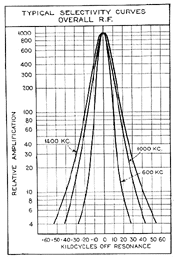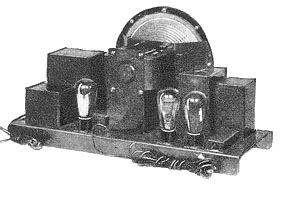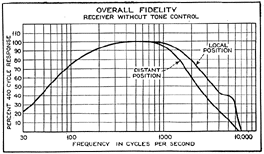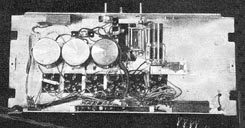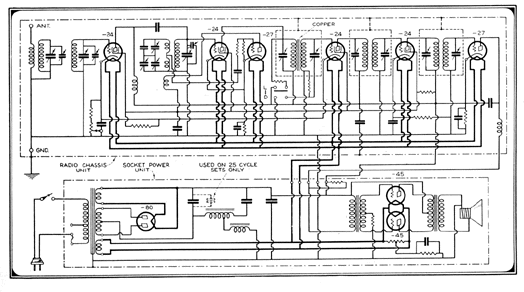RCA Radiola Superheterodyne
By W.L. Carlson, R.S. Holmes, and N.E Wunderlich
The designers of this receiver
The following material has been reproduced from the November 1930 issue of Radio News. In 1930 RCA had released its patents on the Superheterodyne to its licensees, opening the market to greatly improved radio receivers. This RCA model was "state of the art" in 1930. It is also interesting to read the understanding of "high fidelity" described here.
>In order to give the excellent reception to which the present day broadcast
listener is entitled, a receiver must give much better performance than would
have been considered satisfactory a few years ago. It must be able to bring in
the distant stations without interference from powerful local stations, and at
the same time give high quality reproduction of programs coming from nearby
stations.
The superheterodyne circuit is particularly adapted to meet these
difficult requirements. Instead of relying on selecting and amplifying the
signal at the incoming broadcast frequency, by means of circuits which must be
adjusted to that frequency, the superheterodyne changes the broadcast frequency
to a lower, fixed frequency where it can be amplified and unwanted frequencies
eliminated much more efficiently. This fixed frequency is usually called the
intermediate frequency.
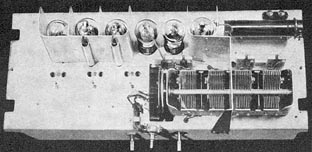
Top view of the RCA receiver chassis
The ease of obtaining high amplification and selectivity
in an intermediate frequency amplifier is chiefly due to the relatively low
frequency used and to the fact that the characteristics of such an amplifier are
independent of the broadcast frequency to which the set is tuned. In the 1930
RCA Radiola superheterodyne an intermediate frequency of 175 kilocycles has been
chosen as the best compromise between amplification, stability, selectivity and
undesired responses.
Roughly the selectivity of a receiver is determined by the
number of selective circuits it has. Thus, ordinary radio-frequency receivers
have three or four tuned circuits. The better ones have five. The 1930 RCA
Radiola superheterodyne has nine selective circuits, three at radio frequency
and six at intermediate frequency. The fidelity of a receiver is usually
considered to be a function of the audio frequency system and the loudspeaker.
This assumption is true in regard to the lower acoustic frequencies. but at
higher acoustic frequencies the high frequency amplifiers, in which the
intermediate frequency amplifiers are included, play a large part. Thus, if the
intermediate frequency characteristic of the receiver is such that it will
attenuate the higher frequency side bands of the broadcast signal, the high
acoustic frequencies will be lacking in the reproduction.
For good fidelity of reproduction, therefore, the resonance charac-teristic of the
receiver should be broad enough to prevent attenuation of the high-frequency side bands. This
characteristic in the 1930 RCA superheterodyne is obtained by the use of coupled
circuits.
PRE-SELECTION and the RADIO-FREQUENCY AMPLIFIER
In order to eliminate extra responses in a superheterodyne, pre-selection at the
incoming broadcast frequency is required. In any type of receiver it is desirable to have some
selectivity before the first tube in order to eliminate inter-ference, such as
secondary modulation. It is also desirable in a super-heterodyne to have a
relatively high signal level at the grid of the first detector (or frequency
changer) tube.
Thus in the 1930 superheterodyne there are two tuned circuits
ahead of the first tube. These two circuits are so coupled as to give high
attenuation to frequencies outside the desired band.
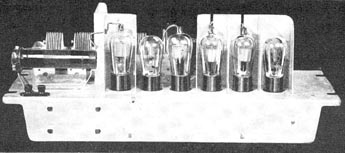
Rear view. The order of the tubes is (L to R) RF, Oscillator, mixer, two IF, and the
detector. The power amplifier and supply was a separate assembly.
Following the radio-frequency tube is a capacity coupled radio-frequency transformer, which, with the tube, gives a uniform amplification of about thirty over the broadcast band.
OSCILLATOR and FIRST DETECTOR
The oscillator circuit is a conventional one
for use with a three-element tube. It consists of a tuned grid circuit with a
plate feed-back coil coupled to it. The grid of the tube is connected to the
mid-tap of the tuned grid circuit to minimize change in oscillator frequency
with tubes. The oscillator is self biased by means of a grid leak and blocking
condenser.
The tuning elements of the oscillator circuit are so designed that
the oscillator frequency is always approximately 175 k.c. higher than the
frequency to which the radio-frequency system is tuned. The oscillator tuned
circuit is coupled to the secondary of the radio-frequency transformer which is
in the grid circuit of the first detector. The coupling is so arranged that the
magnitude of the oscillator voltage on the first detector grid is correct for
the most efficient rectification. In the case of the -24, used in this receiver,
the peak value of oscillator voltage on the first detector grid is seven or
eight volts.
